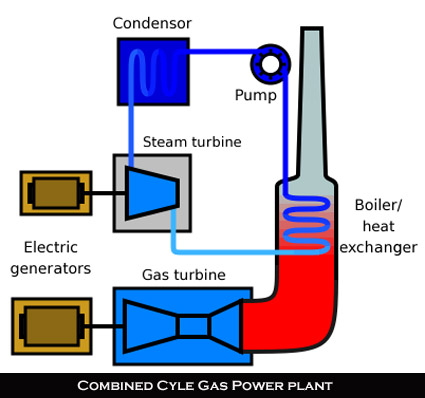Natural Gas vs Coal: Undoubtedly, high efficiency natural gas-fired power stations can produce up to 70% lower greenhouse gas emissions than existing brown coal-fired generators, and less than half the greenhouse gas emissions of the latest technology black coal-fired power stations. Notice the distinction between black and brown coal, however, exactly how much less CO2 also depends upon the type of gas-fired station.
There are three main types: the steam boiler, the gas turbine and the combined cycle. The most efficient natural gas turbines are the combined cycle plants where hot exhaust gases are used to raise steam in a waste heat boiler. A combined-cycle gas turbine power plant consists of one or more gas turbine generators equipped with heat recovery steam generators to capture heat from the gas turbine exhaust. Steam produced in the heat recovery steam generators powers a steam turbine generator to produce additional electric power. Use of the otherwise wasted heat in the turbine exhaust gas results in high thermal efficiency compared to other combustion based technologies.

Gas vs Coal
The CO2 emissions from Natural Gas Combined Cycle (NGCC) plants are reduced relative to those produced by burning coal given the same power output because of the higher heat content of natural gas, the lower carbon intensity of gas relative to coal, and the higher overall efficiency of the NGCC plant relative to a coal-fired plant (1).
“The average emissions rates in the United States from natural gas-fired generation are: 1135 lbs/MWh (Mega Watt hours) of carbon dioxide, 0.1 lbs/MWh of sulfur dioxide, and 1.7 lbs/MWh of nitrogen oxides. Compared to the average air emissions from coal-fired generation, natural gas produces half as much carbon dioxide, less than a third as much nitrogen oxides, and one percent as much sulphur oxides at the power plant.”(2)
In the natural gas vs coal discussion, overall efficiency may also depend on the process of natural gas extraction, treatment, and transport of the gas to the power plant which could generate some additional emissions. As there are still some emissions from natural gas, the Commonwealth Senate Inquiry into Australia’s greenhouse future last year suggested natural gas should be treated as a transition fuel on the path beyond fossil fuels.
Natural gas also allows for smaller ‘distributed generation’ as opposed to large centralised plants, providing autonomy and electricity security at a more localised level. The US Department of Energy, EIA, in conjunction with the Oil and Gas Journal and World Oil publications, estimates world proved natural gas reserves to be around 5,210.8 Tcf (Trillion cubic feet). Most of these reserves are located in the Middle East with 1,836.2 Tcf, or 34 percent of the world total, and Europe and the Russia with 2158.7, or 42 percent of total world reserves.
The United States, by this calculation, possesses 3 percent of the world total natural gas reserves (USA currently burns about 23 trillion cubic feet a year), so gas as a fuel could last for many years (depending on how many power stations come online). Domestic US gas production comes primarily from 5 states: Louisiana, New Mexico, Oklahoma, Texas, and Wyoming. According to the EIA, these 5 states were responsible for just under 80 percent of total marketed natural gas production in 2001. Although most of the natural gas that is consumed in the United States is produced domestically, the US does import some Liquefied Natural Gas (LNG), with the balance of dry natural gas coming from Canada.
Because natural gas has been and still is a relatively cheap fuel, industry and governments have not been overly concerned about energy efficiency. With focus starting to shift and look at emissions, it is starting to be noticed. It still has a long way to go. There is a technology that has been available and used in North America called “Condensing flue gas heat recovery”. This technology is designed to increase the energy efficiency of natural gas and LPG appliances.
So, in the gas vs coal debate… gas is a viable option in the short-medium term, with renewable energy the solution in the long term.
Page last updated: 10 March 2010
References:
1. Cost and Performance Baseline for Fossil Energy Plants DOE/NETL-2007/1281 Volume 1: Bituminous Coal and Natural Gas to Electricity Final Report (Original Issue Date, May 2007) Revision 1, August 2007, Pg.446
